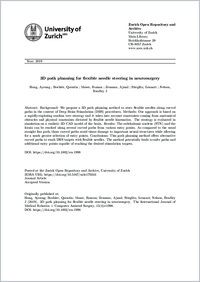3D path planning for flexible needle steering in neurosurgery.
- Hong A Multi-Scale Robotics Laboratory, ETH Zürich, Zürich, Switzerland.
- Boehler Q Multi-Scale Robotics Laboratory, ETH Zürich, Zürich, Switzerland.
- Moser R Multi-Scale Robotics Laboratory, ETH Zürich, Zürich, Switzerland.
- Zemmar A Juha Hernesniemi International Neurosurgery Center, Henan Provincial People's Hospital, Zhengzhou University, Zhengzhou, China.
- Stieglitz L Department of Neurosurgery, University Hospital Zurich, Zürich, Switzerland.
- Nelson BJ Multi-Scale Robotics Laboratory, ETH Zürich, Zürich, Switzerland.
- 2019-04-05
Published in:
- The international journal of medical robotics + computer assisted surgery : MRCAS. - 2019
deep brain stimulation
flexible needle
neurosurgery
surgical planning
Algorithms
Biomechanical Phenomena
Brain
Computer Simulation
Electrodes
Humans
Imaging, Three-Dimensional
Magnetics
Needles
Neurosurgical Procedures
Robotics
Subthalamic Nucleus
Surgery, Computer-Assisted
English
BACKGROUND
We propose a 3D path planning method to steer flexible needles along curved paths in the context of deep brain stimulation (DBS) procedures.
METHODS
Our approach is based on a rapidly exploring random tree strategy, and it takes into account constraints coming from anatomical obstacles and physical constraints dictated by flexible needle kinematics. The strategy is evaluated in simulation on a realistic 3D CAD model of the brain.
RESULTS
The subthalamic nucleus (STN) and the fornix can be reached along several curved paths from various entry points. As compared with the usual straight line path, these curved paths avoid tissue damage to important neural structures while allowing for a much greater selection of entry points.
CONCLUSIONS
This path planning method offers alternative curved paths to reach DBS targets with flexible needles. The method potentially leads to safer paths and additional entry points capable of reaching the desired stimulation targets.
We propose a 3D path planning method to steer flexible needles along curved paths in the context of deep brain stimulation (DBS) procedures.
METHODS
Our approach is based on a rapidly exploring random tree strategy, and it takes into account constraints coming from anatomical obstacles and physical constraints dictated by flexible needle kinematics. The strategy is evaluated in simulation on a realistic 3D CAD model of the brain.
RESULTS
The subthalamic nucleus (STN) and the fornix can be reached along several curved paths from various entry points. As compared with the usual straight line path, these curved paths avoid tissue damage to important neural structures while allowing for a much greater selection of entry points.
CONCLUSIONS
This path planning method offers alternative curved paths to reach DBS targets with flexible needles. The method potentially leads to safer paths and additional entry points capable of reaching the desired stimulation targets.
- Language
-
- English
- Open access status
- green
- Identifiers
-
- DOI 10.1002/rcs.1998
- PMID 30945791
- Persistent URL
- https://folia.unifr.ch/global/documents/77498
Statistics
Document views: 18
File downloads:
- fulltext.pdf: 0
